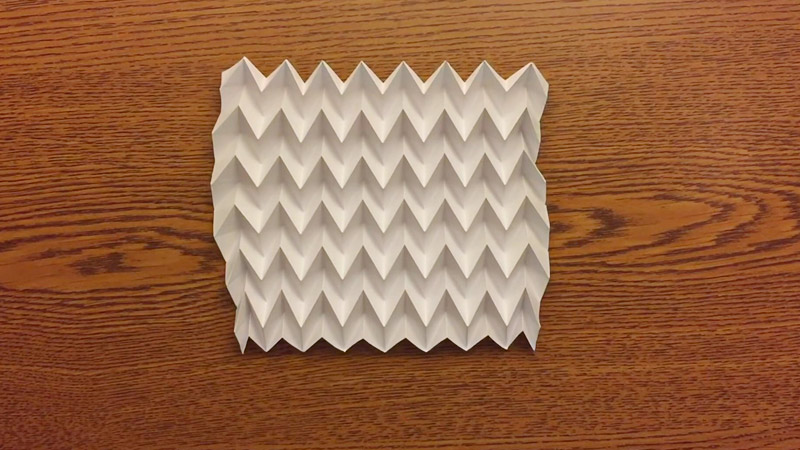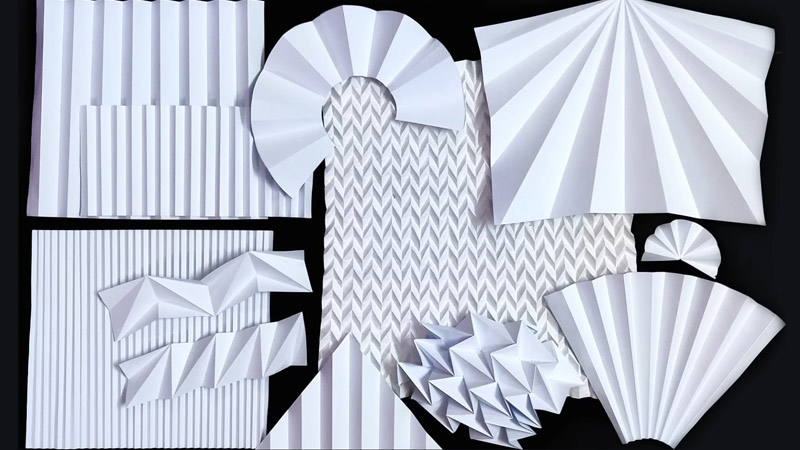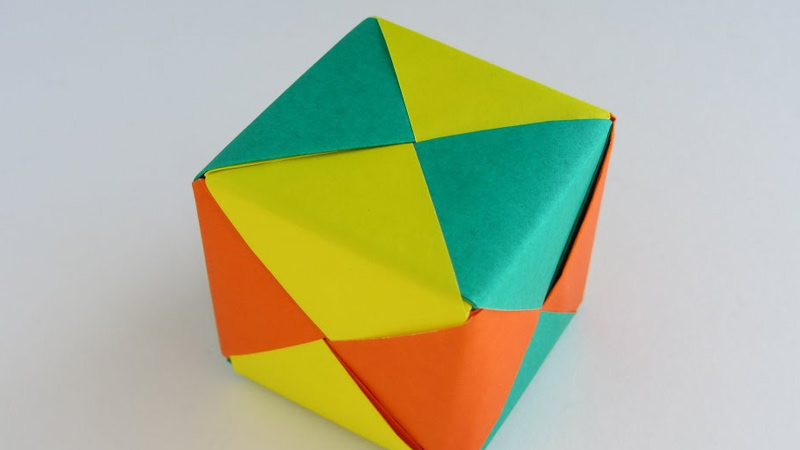Origami pattern making is a captivating extension of the ancient Japanese art of paper folding, offering enthusiasts the opportunity to design and craft their unique folded creations.
Unlike traditional origami, where practitioners follow established models, pattern-making empowers individuals to create personalized designs by experimenting with folds, structures, and arrangements.
This dynamic process involves mastering fundamental folds, exploring mathematical concepts, and embracing creative freedom.
Origami pattern makers design unique pieces that range from intricate tessellations and dynamic kinetic sculptures to elegant modular structures.
The art form invites continuous exploration, fostering innovation and individual expression within the rich tradition of folded paper art.

What Is Origami Pattern Making?
Origami pattern making is a creative and innovative extension of the traditional Japanese art of origami, which involves folding paper to create various shapes and forms.
While traditional origami often follows established models with specific folding instructions, origami pattern-making allows individuals to design and craft their own unique origami creations.
Key aspects of origami pattern making include:
Designing Unique Patterns
Origami pattern makers create their designs, departing from established instructions. This process involves planning and envisioning the desired outcome, allowing for a more personalized and creative approach to paper folding.
Experimentation with Folds
Enthusiasts can experiment with different folding sequences, techniques, and arrangements. This exploration fosters a deeper understanding of the folding process and encourages the development of new and innovative patterns.
Creative Expression
Origami pattern-making provides a platform for personal artistic expression. Creators can infuse their patterns with their unique style, preferences, and artistic vision, creating origami models that reflect their creativity.
Flexibility in Complexity
Pattern makers can choose the level of complexity for their designs. Whether creating simple patterns suitable for beginners or intricate and elaborate models for advanced folders, the flexibility allows for a broad range of origami creations.
Problem-Solving in Design
Designing origami patterns involves addressing structural stability, symmetry, and overall aesthetic challenges. Pattern makers use problem-solving to refine their designs and ensure the successful execution of intricate folds.
Sharing within the Community
Origami pattern makers often share their designs within the origami community. This collaborative aspect fosters inspiration, learning, and the exchange of ideas, contributing to the collective knowledge of the broader origami community.
Personalized Style and Themes
Origami pattern-making allows for incorporating personal style and exploring various themes. Creators can experiment with different motifs, themes, and inspirations, adding a unique touch to their origami patterns.
Use of Various Papers
While traditional origami often involves specialized origami paper, pattern makers can use various paper types. This includes experimenting with different textures, colors, and patterns to enhance the visual appeal of the origami patterns.
Continuous Learning and Evolution
Engaging in origami pattern-making is a journey of continuous learning and evolution. Pattern makers refine their skills over time, learning from both successes and challenges and contributing to the evolution of origami as an art form.
How Can You Create Your Own Unique Origami Patterns?
Creating your own unique origami patterns can be a rewarding and creative process. Here’s a step-by-step guide to help you design your personalized origami creations:
Understand Basic Origami Folds

Ensure you understand basic origami folds, such as valley folds, mountain folds, and inside reverse folds. Familiarize yourself with common origami symbols and terminology used in folding instructions.
Explore Existing Designs
Study a variety of existing origami designs to gain inspiration and insight into different folding techniques. This exploration will help you understand how various folds and arrangements contribute to the overall structure of an origami model.
Choose a Theme or Inspiration
Decide on a theme or source of inspiration for your origami pattern. This could be based on nature, geometric shapes, animals, or abstract concepts. Having a theme will guide your design process and add a cohesive element to your creations.
Sketch Your Design
Use a pencil and paper to sketch your design before folding it. Consider the sequence of folds, the placement of creases, and how the paper will transform into the desired shape.
Sketching helps visualize the final result and allows you to refine your design on paper.
Start with Simple Concepts
If you’re new to creating origami patterns, begin with simple concepts. Experiment with a few folds and explore how they interact to form basic shapes. Gradually add complexity as you become more comfortable with the design process.
Experiment with Folding Sequences
Test different folding sequences to achieve the desired shape. Be open to experimentation and try variations of folds to see how they influence the overall design. Adjustments can be made as you progress, refining your pattern along the way.
Iterate and Refine
Origami pattern-making is an iterative process. Don’t be afraid to adjust and refine your design as you go. Unfold your model if needed, identify areas for improvement, and try alternative folding sequences to enhance your pattern.
Consider Structural Stability
Pay attention to the structural stability of your design. Ensure that the folds you incorporate provide sufficient support to the overall structure. A well-balanced origami pattern looks visually appealing and is stable when folded.
Incorporate Personal Style
Infuse your origami pattern with your personal style. This could involve experimenting with color, varying paper textures, or adding unique embellishments. Your personal touch will make your origami patterns stand out.
Share and Seek Feedback
Share your unique origami patterns with the origami community or friends. Seeking feedback can provide valuable insights, constructive criticism, and new perspectives that may inspire further improvements or variations.
Document Your Designs
Keep a record of your origami patterns by documenting them through sketches, photographs, or digital files. This documentation allows you to revisit and recreate your designs in the future.
Mastering Origami Pattern Making: Top 10 Expert Tips

Mastering origami pattern making is a creative journey that involves honing your skills and developing a deep understanding of folding.
Here are ten expert tips to enhance your proficiency in origami pattern making:
1. Build a Strong Foundation
Master fundamental origami folds and techniques before delving into pattern-making. A solid understanding of basic folds, such as valley and mountain folds, provides a strong foundation for creating more complex patterns.
2. Study Origami Theory
Dive into origami theory and study the principles that govern the art. Understanding concepts like bases, symmetry, and grid theory will empower you to create well-designed and structurally sound origami patterns.
3. Explore Advanced Folds
Familiarize yourself with advanced folds, including sinks, swivels, and closed sinks. These folds add depth and complexity to your designs, allowing you to create intricate patterns with more sophisticated structures.
4. Practice with Precision
Emphasize precision in your folds. Pay attention to alignment, crease accuracy, and symmetry. Consistent and precise folding is essential for achieving your origami patterns’ intended structure and aesthetic.
5. Understand Paper Properties
Gain insight into different paper properties, including thickness, texture, and color intensity. Knowing how different papers behave during folding allows you to choose materials that complement your design goals.
6. Utilize Mathematical Concepts
Explore mathematical concepts such as geometry and proportion. Applying mathematical principles in your designs can lead to more harmonious and visually appealing origami patterns.
7. Experiment with Tessellations
Tessellations involve repeating geometric patterns across a surface. Experimenting with tessellations in origami pattern making allows you to create intricate and visually striking designs.
Study tessellation techniques and incorporate them into your patterns.
8. Combine Traditional and Modern Styles
Blend traditional origami elements with modern design approaches. This fusion allows you to create patterns that are both rooted in tradition and innovative, offering a unique perspective on the art form.
9. Document and Catalog Your Designs
Keep a comprehensive record of your origami patterns. Documenting your designs through sketches, diagrams, or digital files helps you remember your creations and is a valuable resource for future reference and improvement.
10. Engage in the Origami Community
Connect with other origami enthusiasts, attend workshops, and participate in online forums. Engaging with the origami community provides opportunities for learning, sharing ideas, and receiving constructive feedback on your patterns.
Origami Pattern Making Examples That Inspire
Here are some examples of origami patterns that showcase the diversity and creativity achievable through origami pattern making:
Modular Origami Cubes

Create modular origami cubes by interlocking multiple smaller units. Experiment with different colors and arrangements to form visually appealing and geometric patterns.
Kusudama Flowers
Design kusudama flowers by combining multiple folded units to create a spherical origami structure. Experiment with various petal shapes, sizes, and arrangements to craft unique floral patterns.
Origami Tessellations
Explore tessellations, repeating geometric patterns that cover a surface without overlapping. Tessellations in origami can range from simple repetitions to complex and intricate designs.
3D Origami Animals
Craft three-dimensional origami animals using modular folding techniques. Experiment with different animal shapes and sizes to create a menagerie of creatures with intricate patterns and details.
Twisted Origami Boxes
Design origami boxes with twisted or interlocking elements. This pattern adds an extra layer of complexity to traditional origami boxes, creating visually captivating and structurally interesting containers.
Spiral Origami Patterns
Experiment with spiral patterns in origami, creating designs that evoke movement and flow. Spirals can be incorporated into various origami models, adding a dynamic and artistic element to the patterns.
Fractal Origami Designs
Create origami patterns inspired by fractals, repeating mathematical structures that display self-similarity at different scales. Explore how fractal principles can be translated into intricate and mesmerizing origami patterns.
Kinetic Origami Sculptures
Craft kinetic origami sculptures that move or transform. This can include designs that dynamically open, close, spin, or change shape. Kinetic elements add an interactive and engaging dimension to origami patterns.
Quilted Origami Patterns
Design origami patterns inspired by quilting techniques. Explore combining multiple smaller units to create larger quilted patterns, creating visually intricate and textured origami designs.
Folded Star Origami Patterns
Experiment with folded star patterns, creating designs that resemble celestial bodies. These patterns often involve intricate folding sequences to achieve a star-like appearance with a three-dimensional quality.
FAQs
What tools are needed for origami pattern making?
Basic tools include paper, scissors, rulers, and instructions. Optional tools like a bone folder, pencil, and grid paper aid in precision and planning.
Can any paper be used for origami pattern making?
Various papers, including origami paper, printer paper, or unconventional materials, offer flexibility in origami pattern making.
How does origami pattern making differ from traditional origami?
Origami pattern-making deviates from set instructions, empowering creators to design their folds, experiment with complexity, and infuse personal style, while traditional origami follows established models.
To Recap
Origami pattern-making transcends the boundaries of traditional paper folding, unlocking a realm of boundless creativity and personal expression.
This dynamic practice allows individuals to shape their unique visions into intricate, three-dimensional designs.
Fusing artistic intuition, mathematical principles, and skilled folding techniques, enthusiasts can produce captivating patterns ranging from geometric tessellations to kinetic sculptures.
The journey of origami pattern making is one of continuous exploration, where practitioners evolve their skills, contribute to a vibrant community, and leave an indelible mark on the ever-evolving landscape of folded art.
As patterns unfold and possibilities expand, origami pattern-making stands as a testament to the enduring allure of this ancient craft.
Leave a Reply